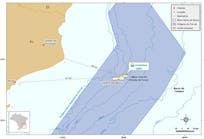Four pay zones found at third Falklands discovery
Rockhopper Exploration PLC reported a “fantastic result” as its third discovery in the North Falkland basin encountered oil and-or wet gas in four hydrocarbon-bearing target zones.
The 14/15-4 exploratory well on the Rockhopper-operated PL004b license penetrated reservoir targets in the Beverley, Casper South, Casper, and Sea Lion main complex for a total of 57 m of net pay in 89 km of gross reservoir.
Rockhopper earned a 60% interest by drilling the well, and Desire Petroleum PLC has a 40% carried interest. The wellsite is 12.1 km southwest of the 14/10-2 Sea Lion discovery well and 6.3 km south of the 14/10-9 Casper discovery well.
The well penetrated the Beverley sand at 2,359 m measured depth rotary kelly bushing, near the structure’s crest, and found 25.8 m of net gas pay with 22% average porosity and 44 md average permeability. Analysis of mud logs indicate likely wet gas.
From the observed formation pressure gradients, Rockhopper believes that the gas-oil contact observed in Casper at the 14/10-9 well and Casper South at the 14/15-4 well is likely to exist in Beverley and as a result Beverley may be oil-bearing downdip.
The well penetrated the Casper South sand at 2,420 m and found 25% average porosity in the gas leg and 27% in the oil leg. Permeability averaged 212 md in the gas leg and 1,011 md in the oil leg. Net gas pay is 8.5 m, and net oil pay is 11.6 m. Mud log analysis indicates likely wet gas.
Casper South, Desire’s Shona prospect, is a separate fan lobe south of and apparently in communication with the Casper fan, which the company currently maps as greater than 100 sq km in areal extent with large downdip oil potential.
The well penetrated the Casper sand at the feather edge of the mapped fan lobe. The Casper reservoir is at 2,450 m and entirely below the gas-oil contract at the 14/10-9 well. The Casper sands are all oil-bearing at 14/15-4. The company believes the 14/15-4 well defines the southernmost limit of Casper with a thin reservoir section of low net-to-gross sand.
“The presence of Casper at this location enables us to confirm mapping of this fan lobe to the maximum extent of its seismic expression and increase the volumes currently carried for this prospect,” Rockhopper said. Analysis of mud logs at the 14/10-9 well indicates wet gas.
The 14/15-4 well penetrated the Sea Lion main complex at 2,474 m, and the company believes the well is close to Sea Lion’s southernmost limit at the outer edge of its former maximum case area. Formation pressure testing established that the oil lies on the same pressure gradient as the rest of the field, and Rockhopper recovered oil samples for PVT analysis.
The company will complete a short-offset sidetrack of 10 km to core the Beverley, Casper South, and Sea Lion main complex.
Rockhopper received final processed 3D seismic on PL032, PL033, and PL004b, its northern operated acreage, and once interpreted will provide updated guidance on potential volumes in the four reservoir intervals.

Alan Petzet | Chief Editor Exploration
Alan Petzet is Chief Editor-Exploration of Oil & Gas Journal in Houston. He is editor of the Weekly E&D Newsletter, emailed to OGJ subscribers, and a regular contributor to the OGJ Online subscriber website.
Petzet joined OGJ in 1981 after 13 years in the Tulsa World business-oil department. He was named OGJ Exploration Editor in 1990. A native of Tulsa, he has a BA in journalism from the University of Tulsa.
